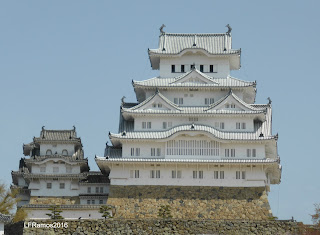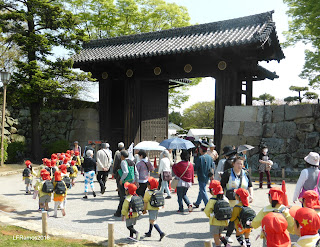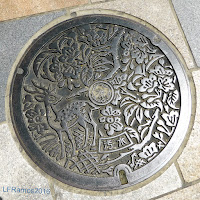 |
| The installation art by Toym Imao is inspired by the sarimanok. |
"Ako ay isang diwata. Lahat tayo ay diwata. [I am a fairy. All of us are fairies.] We, the graduates, have the potential to soar through the stratosphere. From the rocks of Oble on the ground to the cosmic domain of Diwata [the first micro-satellite of the Philippines], our family, friends, university officials, and professors have shaped us to take flight. Let us thank them by soaring to the sky. Pumailanlang na tayo. Mabuhay ang mga bagong diwata! [Let's all soar. Long live the new fairies!]"
That's how Alexander Atrio Lim Lopez invited his fellow graduates to go out to the world during the 105th Pangkalahatang Pagtatapos [General Commencement Exercises] of the University of the Philippines Diliman on 26 June 2016. He was speaking on their behalf along the theme"Diwata and Oble, Me and You."
Lopez was one of the thirty summa cum laude that led Class 2016 comprising 4,552 graduates from 27 degree-granting units: 3,580 who received their undergraduate degrees and 972 their graduate degrees (70 of which were conferred their doctorates).
 |
| Alexander Lopez, summa, spreads his arms as if to soar like Diwata (the satellite), or a diwata (mythical fairy). |
Lopez was one of the thirty summa cum laude that led Class 2016 comprising 4,552 graduates from 27 degree-granting units: 3,580 who received their undergraduate degrees and 972 their graduate degrees (70 of which were conferred their doctorates).
The top three among the summa were Miguel Ricardo R. Leung, BS Molecular Biology and Biotechnology (WAG of 1.0375); Miguel Raymundo C. Gutierrez, BS Economics (1.064) and Danilo Lorenzo S. Atanacio, BS Economics (1.074).
 |
| The six summa from the College of Engineering with college and university officials. |
Lopez was a former student of UP Manila where he earned his BS Basic Medical Sciences degree under the 7-year Intarmed program. Instead of pursuing the MD program, he opted to enroll at the College of Social Sciences and Philosphy in the Diliman campus. He earned hi BA Philosophy with a WAG of 1.1810.
He recalled that back then in his third year of Intarmed, he knew that he will not be a medical doctor.
"I already knew I loved philosophy," he said, "but I also thought about the lower pay that philosophers got compared to medical doctors and maybe more importantly, the lower respect that philosophers received. My failure was I wasn’t brave enough to accept and fully defend what I loved."
Even if his classmates were being shaped by the UP College of Medicine, he wanted his "rock to have a shape different from medicine to support Oble."
Lopez looked at Oble [the Oblation] as a representation of "each Iska and Isko [short for scholar of the people, or Iskolar ng bayan] and each person," The iconic statue of UP stands with its head looking up, its arms outstretched with palms up standing on a pedestal of rocks. "The rocks are like the differently-shaped disciplines that make up UP" and "[e]ach discipline, whether it be from the sciences or humanities, has a different character. The combination of these differences allows humans to soar," he said.
 |
| A graduating UP Pep Squad 'soars' as her dean presented the members of their class. |
He reminded Class 2016: "When we are inspired, we do our best
work. When we do our best work, we can offer the best service to our countrymen,
which is after all, what Oble is known to symbolize. It is in the interest of
society that we put each other in situations that will inspire us to do our
best work for the people. When scientists, artists, and philosophers do their
best, it is not only the individual but also society that soars.
"We need all of them. In a tragedy where
49 people were shot dead, it’s medical science that heals the victims’ bodies
and minds, it’s art that inspires survivors to move forward, and it’s
philosophy that forms ethics to prevent another moral disaster.
"I have acquired scientific precision
from medicine, artistic expression from creative writing, and rational
open-mindedness from philosophy. All these have shaped the rock that I give in support of Oble’s soaring. Fellow
graduates, we all have our shapes that are distinct and beautiful—beautiful
like a diwata."
As each one builds his or her life in the real world, UP President Alfredo Pascual invoked in his keynote speech that this be done with integrity and honor, tenets that the university builds into the minds of its students.
Pascual invited them to give this a thought: join the academe and help mold the minds of future nation-builders.
Up above Quezon Hall and the colorful installation art based on the sarimanok by Toym Imao is t he call to graduates of UP, the national university: Paglingkuran Ang Sambayanan [Serve the People].
As each one builds his or her life in the real world, UP President Alfredo Pascual invoked in his keynote speech that this be done with integrity and honor, tenets that the university builds into the minds of its students.
 |
| The clinched fist in the singing of the University Hymn. |
Pascual invited them to give this a thought: join the academe and help mold the minds of future nation-builders.
Up above Quezon Hall and the colorful installation art based on the sarimanok by Toym Imao is t he call to graduates of UP, the national university: Paglingkuran Ang Sambayanan [Serve the People].
 |
| The lightning protest toward the end of graduation rites each year. |























